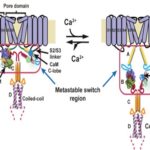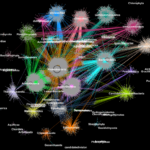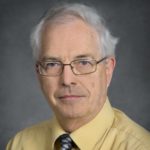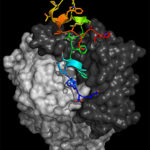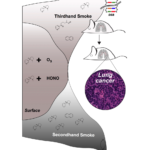The Kv7 family of voltage-gated potassium channels control excitability in the heart, brain, and ear, and harbor mutations associated with arrhythmias, epilepsy, and deafness. A recent study, led by Molecular Biophysics and Integrated Bioimaging (MBIB) faculty scientist Daniel Minor’s group in the Cardiovascular Research Institute at UCSF, used both diffraction and scattering beamlines of ALS-ENABLE to reveal a universal switch mechanism by which the calcium sensor protein calmodulin controls the action of these channels. The findings, reported in the journal Neuron, provide a key link between Kv7 channel activity and cellular signaling pathways. Greg Hura, a research scientist in MBIB, was also a co-author on the paper. Watch a video detailing the work.
JGI Helps Develop Metagenomic Clustering Algorithm Powered by HPC
On a social network like Facebook, each user (person or organization) is represented as a node and the connections (relationships and interactions) between them are called edges. By analyzing these connections, researchers can learn a lot about each user. In biology, similar graph-clustering algorithms can be used to understand the proteins that perform most of life’s functions. Today, advanced high-throughput technologies allow researchers to capture hundreds of millions of proteins, genes and other cellular components at once and in a range of environmental conditions. Clustering algorithms are then applied to these datasets to identify patterns and relationships that may point to structural and functional similarities. Though these techniques have been widely used for more than a decade, they cannot keep up with the torrent of biological data being generated by next-generation sequencers and microarrays. In fact, very few existing algorithms can cluster a biological network containing millions of nodes (proteins) and edges (connections). That’s why a team of Berkeley Lab researchers, including scientists at the Joint Genome Institute (JGI), took one of the most popular clustering approaches in modern biology—the Markov Clustering (MCL) algorithm—and modified it to run quickly, efficiently and at scale on distributed-memory supercomputers. In a test case, their high-performance algorithm—called HipMCL—achieved a previously impossible feat: clustering a large biological network containing about 70 million nodes and 68 billion edges in a couple of hours, using approximately 140,000 processor cores on the National Energy Research Scientific Computing Center’s (NERSC) Cori supercomputer. A paper describing this work was recently published in the journal Nucleic Acids Research. Read the whole story on the Berkeley Lab Computational Research Division site.
Crucial Surface Intermediate for Photocatalytic CO2 Reduction Identified
Catalytic carbon dioxide (CO2) reduction is an important technology for the production of fuels and chemicals. Mechanistic studies have suggested that both electro- and photocatalytic approaches may share a common intermediate: a carbon dioxide radical anion (CO2–) bound to the catalyst’s surface. Now, using rapid-scan Fourier-transformed infrared spectroscopy in combination with isotopic labelling, Heinz Frei, a senior scientist in Molecular Biophysics and Integrated Bioimaging (MBIB), and colleagues have identified a carbon dioxide dimer radical anion (C2O4–) as the crucial surface intermediate during the photocatalytic reduction of CO2 on copper nanoparticles. Although recent electrochemical investigations have suggested the existence of this one-electron surface intermediate, this study, published in the Journal of the American Chemical Society (JACS), provides the first direct experimental evidence. Read more in this Nature Catalysis research highlight.
ALS Enables Structural Determination of Respiratory Virus-Antibody Complex
Using diffraction data collected at cryogenic temperature at the Advanced Light Source (ALS) Beamline 8.3.1, University of California Santa Cruz (UCSC) scientists, led by assistant professor of biomolecular engineering Rebecca DuBois, determined the three-dimensional atomic structure of a major surface protein of the respiratory syncytial virus (RSV): RSV G. Medical researchers have been trying to develop a vaccine for RSV, which causes serious respiratory disease in infants and older adults, for more than 50 years without success. But by leveraging the work of collaborators at Trellis Bioscience, who isolated protective human antibodies targeting RSV G, an attachment protein that allows the virus to stick to lung cells, the UCSC scientists were able to show that these protective antibodies target a section of the protein called the central conserved domain that is the same in all strains of the virus. The findings, published March 9 in Science Immunology, point to a promising route for designing a vaccine effective against a broad range of RSV strains. Read more from the UC Santa Cruz News Center.
Thirdhand Smoke Found to Increase Lung Cancer Risk in Mice
Cigarette smoke contains myriad compounds that are known mutagens and carcinogens, and the health risks associated with active smoking and secondhand smoke are well established. Nearly 10 years ago, researchers at Berkeley Lab identified another potentially hazardous source of tobacco exposure: “thirdhand smoke,” the toxic residues that linger on indoor surfaces and in dust long after a cigarette has been extinguished. A team led by Antoine Snijders, Jian-Hua Mao, and Bo Hang in Biosciences’ Biological Systems and Engineering (BSE) Division have determined that early thirdhand smoke exposure is also associated with increased incidence and severity of lung cancer in mice.
- « Previous Page
- 1
- …
- 128
- 129
- 130
- 131
- 132
- …
- 214
- Next Page »
Was this page useful?


